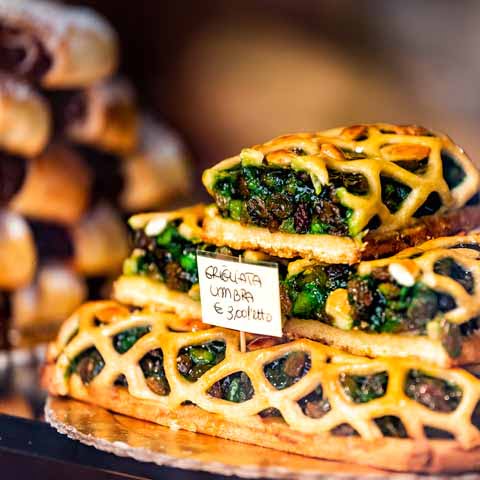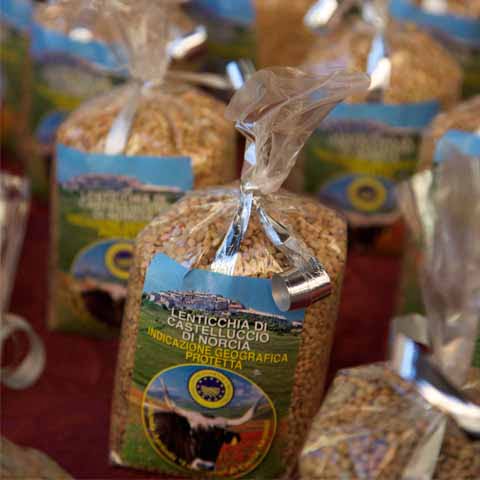Located in the region of Umbria, a region known for its flavorful cuisine, Gubbio offers excellent quality dishes that are crafted from ancient recipes and local, fresh ingredients. Dishes in Gubbio are heavily based in meats, cheeses, and vegetables.
More notable than any of these ingredients, however, are the black and white truffles that the region is known for. Gubbio, in particular, is known for its abundance of white truffles and, as a result, the town is a delight for foodies looking to try this rare ingredient. Truffles are featured in many local dishes and travelers can even purchase truffle-infused products at shops throughout the town, including oils, pastes, cheeses, and more.
APPETIZER
To whet the appetite in Gubbio, travelers can enjoy a trademark local dish called brustengo. This dish consists of fried bread that is served with meat such as bacon, ham, and sausage and delicious flavors such as onion and rosemary.
Of course, cured meats are popular as well including local salame made with boar or deer, capocollo, prosciutto, and pancetta. Also included favored among the locals are cheeses such as pecorino and scamorza, a stretched-curd cheese made from cow’s milk.
Cured meats and cheeses may be accompanied by crescia al panaro, a local flatbread that is baked on a griddle. The bread may also accompany local stews made with lamb, rabbit, chicken, or duck.
FIRST COURSE
For the first course in Gubbio, expect to find a variety of homemade pasta dishes that highlight the ingredient of choice in Umbria – truffles. Examples of these types of truffle infused pastas include lasagna tartufata – a lasagna made with salty prosciutto and truffles, tagliatelle al tartufo made with a truffle sauce, and stringozzi with truffles – an Italian wheat pasta that is long, rectangular, and served with local black truffles.
Often, stringozzi can also be served with a meat ragù or a tomato sauce. Tiny ravioli, known as raviolini, can be served with asparagus.
Outside of pasta, travelers can expect the first course to feature gnocchi, or potato dumplings. One delicious gnocchi dish is gnochetti al finocchio selvatico – potato dumplings with wild fennel. Another is gnocchi with goose ragù.
SECOND COURSE
The second course dishes in Umbria, including Gubbio, are characterized by meaty, rich flavors brought out by either grilling meat over an open flame or slow cooking it to release the depth of flavor.
Some second course dishes one may find in Gubbio include suprema di faraona – guinea fowl in a lightly spiced sauce, pork made with Sargentino wine and onions, baked lamb, and a variety of roasted meats.
Gubbio, in particular, is known for its friccò. This term refers to how meat, typically lamb, duck, chicken, pork, or rabbit is cooked slowly in terracotta pots, very similar to stew. The dish is popular throughout Umbria with families creating their own variations.
In some cases the stew may even include a mixture of meats. It is often accompanied by the local flatbread called crescia. No matter what recipe is followed, friccò is a must-try in Gubbio.
As far as fish, cod is served after being dipped in milk and baked.
A local second course dish without any meat or fish is brosega, which is made with tomatoes and scrambled eggs.
SIDE DISHES
Alongside meals in Gubbio, one will find crescia al panaro, a savory type of focaccia bread. This delicious bread is typically served with local cold cuts, sliced meats, or friccò (stew) of lamb, duck, chicken, or rabbit.
While not a side in itself, truffle oil deserves a mention as it is a quintessential ingredient in many Umbrian dishes. This prized ingredient is often drizzled atop pastas and infuses just the right amount of truffle flavor into nearly anything.
Bandiera (Italian for flag) is a typical Umbrian side dish made with peppers, onions, and tomatoes. The ingredients are cut into strips and sauteed before being served.
STREET FOOD
Weekly fresh food markets and various food festivals throughout the year are the best way to enjoy food on the streets of Gubbio.
The city is home to the annual White Truffle Festival, an event dedicated to celebrating and showcasing the region’s most prized product – white truffles. The event features chefs and truffle experts from all across Italy as they showcase their recipes and products. Visitors to the fair can choose from a wide array of restaurants and booths to enjoy truffle-focused food.
Gubbio features a variety of other festivals as well, including a specific festival dedicated to the best street food of the area.
DESSERTS
Many of the region’s desserts, including those served in Gubbio, have traditional origins.
While traveling in Gubbio, one will find a variety of delectable cakes, crêpes, and more. The area offers traditional desserts such as cheesecake and pastries covered with chocolate or stuffed with caramel as well as more unique offerings such as poached pears.
The most traditional dessert served are ganascioni, crescent-shaped desserts that are filled with a mixture of cheese, eggs, cinnamon, and sugar.
Many, though not all, of the desserts available in the area have roots in Christmastime, which is fitting considering the popularity of the Christmas events which are held throughout Gubbio during the holiday season.
WINE
Although Gubbio itself is not a major wine production area, travelers can still enjoy a variety of amazing wines, as the city is located in Umbria – one of the lesser-known but no less spectacular wine producing regions in the country.
In Umbria, there are so many undervalued and undiscovered wines to try, including clean, crisp whites as well as full-bodied, rich reds.
Some of the most notable reds include Rubesco Riserva and Sagrantino di Montefalco. In regards to white wine, Umbria’s most famous is by far Orvieto, a unique white that is offered in a few variations, including dry, semi-sweet, and sweet.
In addition to wine, travelers can enjoy birra alla spina, or draught beer, in quaint beer gardens.
Gubbio’s cuisine offers a perfect introduction to the food and wine of the Umbria region. After a day of admiring the city’s medieval architecture, enjoy a nice dinner of stringozzi, friccò, and crescia al panaro accompanied by a glass of Umbrian wine — it does not get much better than this!
Travel Guides
The Umbria Region of Italy
The Cities of Umbria, Italy










